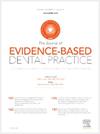阻塞性睡眠呼吸暂停患儿牙弓的三维特征:系统回顾和荟萃分析
IF 4
4区 医学
Q1 DENTISTRY, ORAL SURGERY & MEDICINE
引用次数: 0
摘要
目的阻塞性睡眠呼吸暂停(OSA)患儿可能具有特定的牙弓特征,为临床早期筛查OSA患儿提供一定的指导。本研究旨在评估儿童和青少年OSA与牙弓三维特征之间的关系。方法根据PRISMA指南对临床试验进行系统评价和荟萃分析。检索了PubMed、Embase、Scopus、Cochrane Library和Web of Science数据库,检索时间从建站到2024年4月6日。本综述考虑了评估18岁以下OSA患者牙弓特征的临床研究。采用RevMan5.4软件进行meta分析。结果共纳入8项研究,共纳入466名受试者。meta分析显示,与正常组相比,OSA组的上弓宽度和下弓长度显著减少(MxW1: MD = −1.45,95% CI[−2.71 ~−0.18],P = .02;MxW2: MD = −1.60,95% CI -2.24−0.96,P & lt;.00001;MxW3: MD = −1.21,95%可信区间1.80−−0.62,P & lt;。;MxW4: MD =−1.35,95%可信区间2.37−−0.34,P = .009;下弓长:MD= - 0.84, 95% CI [- 1.23 ~ - 0.45], P <;。)。OSA组与打鼾的非OSA组在上弓宽度、上弓长度和腭高方面均无显著差异(MxW1: MD=−0.23,95% CI [0.81 ~ 0.35], P = .43;MxW4: MD = −0.14,95%可信区间(−1.09到0.80),P = 1:8);上弓长度:MD=−0.26,95% CI[−1.05 ~ 0.49],P = .50;腭高度:MD =−0.82,95% CI(−0.45到2.09),P = .21)。结论:与正常儿童相比,OSA儿童的上弓略窄,下弓略短(差异在1 ~ 1.5 mm之间)。打鼾的非阻塞性睡眠呼吸暂停儿童的牙弓形态与阻塞性睡眠呼吸暂停儿童相似。然而,这些发现需要谨慎看待,因为它们的确定性非常低,并且只考虑了横断面研究,相应的差异可能没有临床意义。本文章由计算机程序翻译,如有差异,请以英文原文为准。
THREE-DIMENSIONAL FEATURES OF DENTAL ARCH IN CHILDREN WITH OBSTRUCTIVE SLEEP APNEA: A SYSTEMATIC REVIEW AND META-ANALYSIS
Objectives
Children with obstructive sleep apnea (OSA) may have specific dental arch features, which may provide some guidance for early screening for OSA in children in clinical practice. This study aimed to evaluate the association between OSA and dental arch 3-dimensional features in children and adolescents.
Methods
This systematic review and meta-analysis of clinical trials was conducted according to PRISMA guidelines. PubMed, Embase, Scopus, Cochrane Library and Web of Science databases were searched from inception to April 6, 2024. Clinical studies assessing dental arch features in patients with OSA under the age of 18 years were considered for this review. A Meta-analysis was performed using RevMan5.4 software.
Results
Eight studies with a total of 466 subjects were included at the end. Meta-analysis showed that upper arch width and lower arch length were significantly reduced in the OSA group compared to the normal group (MxW1: MD = −1.45, 95% CI [−2.71 to −0.18], P = .02; MxW2: MD = −1.60, 95% CI [-2.24 to −0.96], P < .00001; MxW3: MD = −1.21, 95% CI [−1.80 to −0.62], P < .0001; MxW4: MD= −1.35, 95% CI [−2.37 to −0.34], P = .009; lower arch length: MD= −0.84, 95% CI [−1.23 to −0.45], P < .0001). No significant differences were found in upper arch width, upper arch length and palatal height between the OSA group and the snoring non-OSA group (MxW1: MD= −0.23, 95% CI [0.81 to 0.35], P = .43; MxW4: MD = −0.14, 95% CI [−1.09 to 0.80], P = .7; upper arch length: MD= −0.26, 95% CI [−1.05 to 0.49], P = .50; palatal height: MD= −0.82, 95% CI [−0.45 to 2.09], P = .21).
Conclusion
this review shows that OSA children tend to exhibit slightly narrower upper arches and shorter lower arches compared to normal children (differences between 1 and 1.5 mm). Snoring non-OSA children had similar dental arch morphology compared to OSA children. However, these findings need to be viewed with caution as they are of very low certainty and only cross-sectional studies were considered, and the corresponding differences may not be clinically significant.
求助全文
通过发布文献求助,成功后即可免费获取论文全文。
去求助
来源期刊

Journal of Evidence-Based Dental Practice
DENTISTRY, ORAL SURGERY & MEDICINE-
CiteScore
6.00
自引率
16.70%
发文量
105
审稿时长
28 days
期刊介绍:
The Journal of Evidence-Based Dental Practice presents timely original articles, as well as reviews of articles on the results and outcomes of clinical procedures and treatment. The Journal advocates the use or rejection of a procedure based on solid, clinical evidence found in literature. The Journal''s dynamic operating principles are explicitness in process and objectives, publication of the highest-quality reviews and original articles, and an emphasis on objectivity.
 求助内容:
求助内容: 应助结果提醒方式:
应助结果提醒方式:


